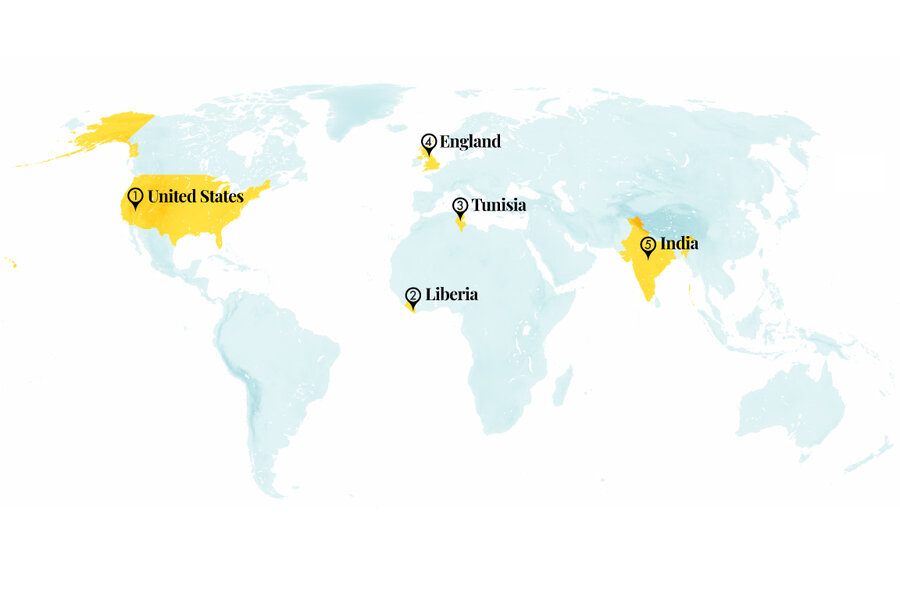Meeting unique needs: From sign language TV to teen pregnancy prevention
Loading...
1. United States
More than half a million acres of public land sacred to 12 Native American tribes have been set aside as the Avi Kwa Ame National Monument. Avi Kwa Ame – or Spirit Mountain – at Nevada’s southern tip is considered to be the center of creation by Yuman tribes like the Fort Mojave.
The revered surrounding area is home to a Joshua tree forest and provides key habitats for the desert bighorn sheep, desert tortoise, and Gila monster. Creating a safe migratory path for animals, the national monument will link otherwise fragmented preserves – the Mojave Desert to the west and Lake Mead area to the east. Last month, President Joe Biden also designated the Castner Range National Monument, in El Paso, Texas, which is home to desert wildlife and more than 40 archaeological sites.
Why We Wrote This
A story focused onIn our progress roundup, there’s recognition that different sectors of society may require tailor-made solutions to problems. In Liberia, when teenagers had access to health information with fewer adults around, pregnancy rates dropped.
The governor of Nevada raised concerns about potential rare-earth mining and economic development projects blocked by the conservation designation. But for years, there has been growing tribal support for protecting Avi Kwa Ame.
“I really see this as a template for the future,” said Taylor Patterson, executive director of Native Voters Alliance Nevada. “Not often do we have outdoor recreation people working with tribes. It’s symbolic of what all land designation in the future should be like.”
Sources: The New York Times, Reuters
2. Liberia
Public health interventions halved teen pregnancy rates in southern Liberia. After establishing programs such as youth-specific health care at existing facilities and peer-led education at school clubs, teen pregnancy rates, at 57.9% in 2013, had dropped to 27.2% by 2020.
Youth-oriented spaces, officials say, have helped teenage girls and boys feel less embarrassed when they seek family planning services and education, or treatment for sexually transmitted diseases. In 2017, the United Nations Population Fund, backed by the Swedish government, began expanded efforts in southern Liberian counties where the teen pregnancy rate of 49% was 1 1/2 times the national average.
In addition to being dangerous for the mother’s health, teen pregnancies are a leading cause of girls dropping out of school, and many of those pregnancies are the result of rape. Some 47% of teenage girls with no education in Liberia have children.
Sources: FrontPage Africa, United Nations Population Fund
3. Tunisia
Solar energy has empowered a struggling boarding school in ways it hopes can be replicated for others. Photovoltaic panels at the Makthar preparatory school aren’t just powering the campus in this ancient northern Tunisian town. Excess electricity also helps three nearby schools, with more sold back to the national grid for about $1,915 a year. Students now have access to warm rooms during the winter, hot showers, and lights to help them study after dark.
This is a far cry from where the school was a decade ago, when it lacked heat, clean drinking water, and electricity. But as the country struggles economically and politically, poor school conditions across the country are part of the reason thousands of students drop out. “I hope the successful experience of this school as a social enterprise can help save the deteriorating public school sector across Tunisia,” said Lotfi Hamadi, a Tunisian entrepreneur who raised funds for the solar panels. A 20-acre farm attached to the school also provides fresh veggies for children and jobs for six previously unemployed parents.
Source: Context
4. England
The first TV game show specially designed for users of British Sign Language (BSL) is being produced with deaf contestants, host, and crew. Traditional game shows don’t translate well for deaf people, where audio clues and the mainstream culture of the hearing world favor people who can hear. Each Sign2Win episode draws on questions based around deaf history and deaf culture. Questions can involve spelling in sign language and picture-based clues.
“When asked why they wanted to be on the show, some contestants welled up, saying they’d watched gameshows all their life and loved them – but could never apply,” said Olivia van der Werff, a broadcasting consultant who worked on the show. “Finally, Sign2Win has given them the opportunity to make their dream of being on a gameshow come true.”
Sign2Win was commissioned by the British Sign Language Broadcasting Trust, which helps broadcasters meet regulatory requirements for programming that includes BSL.
Sources: Positive.News, Broadcast
5. India
India is upgrading its infrastructure, leading to faster transportation routes for goods and people in the 1.3 million-square-mile country. Eight locally designed, semi-high-speed train lines have been inaugurated in the last six months, after the first Vande Bharat Express was opened in 2019. Some 500 more are planned over the next three years, along with a high-speed line between Mumbai and Ahmedabad that will cut travel time from six hours to two.
“It’s so much more comfortable!” said passenger M. Afzal, a cloth dealer on a Vande Bharat train from Varanasi to Kanpur. “But the main thing is the saving of time.”
Two new electric freight train corridors are expected to be fully running next year. Four more are planned. Meanwhile, the rural road network has nearly doubled since 2014 to 453,000 miles, and the number of airports in the country has doubled.
The country is slated to spend 1.7% of its GDP – $122 billion – on transportation infrastructure this year. With deep investments in its digital, transport, and energy networks, the central government hopes to spread economic development and prosperity more widely across the country.
Source: The Economist







